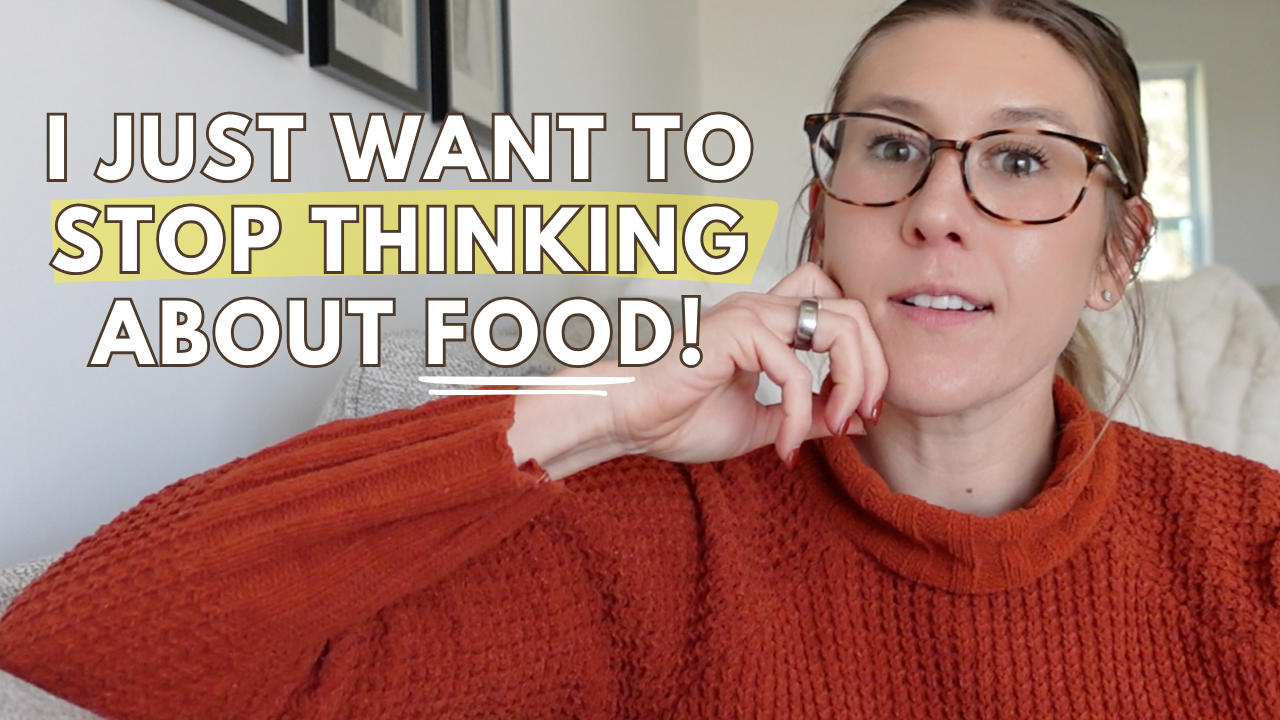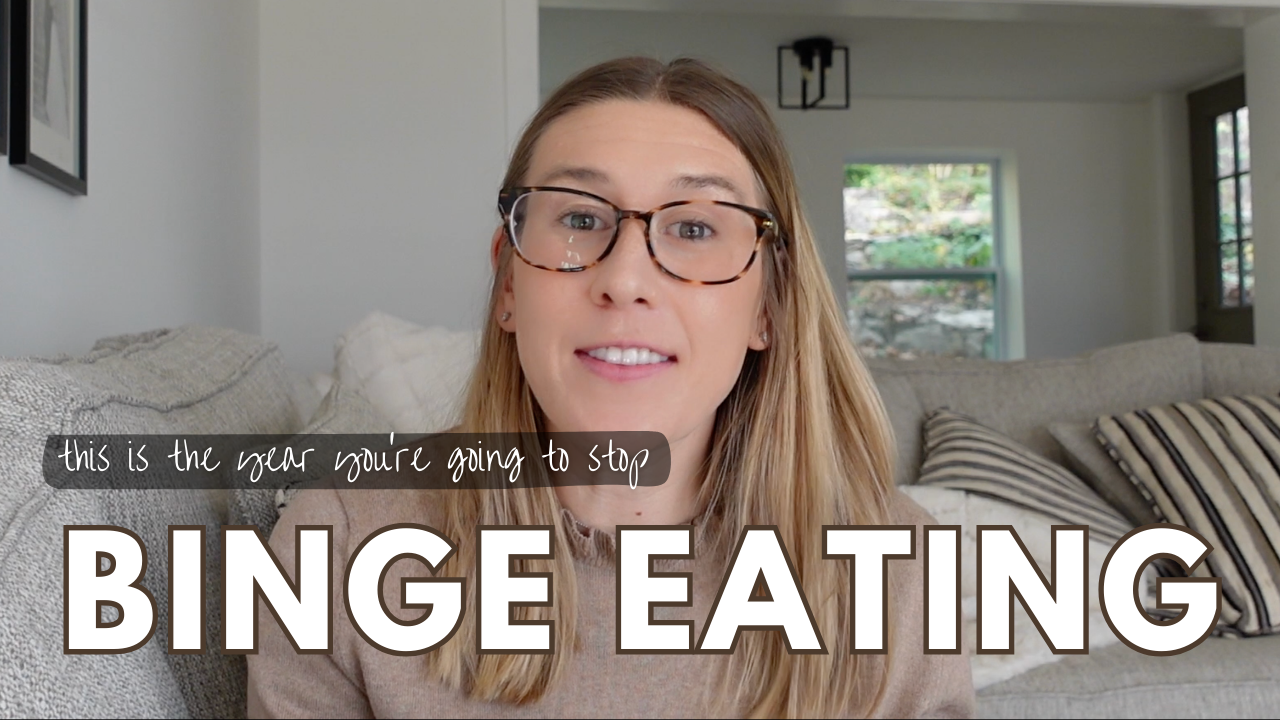Binge Eating vs. Emotional Eating: What’s the Difference?
September 30, 2020

Hey There, I'm Ryann Nicole.
I’m a recovered binge eater who changed the story from something that happened to me to something that happened for me. Now, I’m a licensed therapist teaching you to do the same.
My mission? To help you ditch food stress and live your life with mental peace and freedom every single day!
When it comes to our eating habits and how we feel about food, we often hear about two things: binge eating and emotional eating. These terms are sometimes used like they mean the same thing, but they’re actually quite different. Knowing the contrast between binge eating and emotional eating is an important step in improving our relationship with food. In this post, we’ll break it down into simpler terms to make it easier to understand.
Binge Eating:
Binge eating is a form of disordered eating characterized by consuming larger than usual amounts of food in a short period of time while feeling a lack of control over the eating. Here are some key features of binge eating:
- Rapid Eating: When someone’s binge eating, they eat super quickly. They don’t really taste the food, and it feels like they can’t stop.
- Mixed Feelings: A binge starts with a burst of excitement. It might even feel like a high, but that good feeling doesn’t last long. It’s quickly replaced with bad feelings like disgust, shame, and anger.
- Losing Control: When someone’s binge eating, they can’t stop. It’s like they’re watching themselves eat, but they can’t do anything to control it.
- Keeping It a Secret: Binges usually happen in secret. People who binge eat try really hard to hide it, so it feels like they’re living a double life.
- Eating Specific Foods: When there aren’t many choices, someone might binge on whatever food is around. But if they can choose, the foods they eat during a binge are usually the ones they’ve been trying to avoid or not eat.
Emotional Eating:
Emotional eating, on the other hand, is a broader term that encompasses a wide range of eating behaviors in response to emotions. Here’s what you need to know about emotional eating:
- Eating for Comfort: Emotional eating involves turning to food as a source of comfort when facing emotional challenges. It can be a way to soothe stress, sadness, or anxiety.
- Variety of Emotions: Emotional eating can be triggered by both negative and positive emotions. People may indulge in food to celebrate or reward themselves as well.
- Mindless Eating: Emotional eating may involve eating without paying attention to hunger or fullness cues, and it often leads to overeating.
- Temporary Relief: While emotional eating can provide temporary emotional relief, it does not address the underlying emotional issues and can lead to guilt or regret.
- Common Behavior: It’s important to note that almost everyone engages in emotional eating at some point. It becomes problematic when it is the primary way of coping with emotions.
Key Differences:
The big difference between binge eating and emotional eating is that binge eating is when you can’t control how much you eat during a specific episode, while emotional eating is about using food to deal with feelings. Emotional eating doesn’t always mean eating a huge amount in one go like binge eating.
In short, binge eating and emotional eating are similar in that they both involve feelings and food, but they are different patterns of behavior. Binge eating is more serious and has specific features, while emotional eating is a broader term covering a variety of emotional eating habits. Understanding these differences can help us get the right support and find better ways to cope with our feelings and food. If you’re struggling with binge eating or emotional eating, it’s a good idea to talk to a healthcare professional or therapist to help you have a happier, healthier relationship with food and emotions.
10 Things To Add To Your Coping Box
Just so you know, I do review everything I recommend. When you buy through links on this page, we may earn a commission.
An emotional coping box, also known as a self-soothe or comfort box, is a personalized collection of items that can help individuals cope with difficult emotions, stress, or challenging situations. It’s a tangible and accessible resource that provides comfort and distraction during moments of distress. Here are 10 things you can consider adding to your emotional coping box:
Include items that bring you comfort, such as a soft blanket, stuffed animal, or cozy socks. These tactile objects can provide a sense of security and grounding.
Write down or print out affirmations and positive quotes that resonate with you. Reading these affirmations can help shift your mindset and promote self-compassion.
Incorporate items that engage your senses, such as scented candles, essential oils, or stress-relief lotion. Pleasant scents can have a calming effect.
Include small items like stress balls, fidget spinners, or textured toys. These can serve as a physical outlet for nervous energy and help redirect focus.
Keep a journal or notebook to write down your thoughts, feelings, and reflections. Journaling can be a therapeutic way to express and process emotions.
Include pictures of loved ones, happy memories, or items that hold sentimental value. Visual reminders of positive experiences can bring comfort and perspective.
Guided Relaxation or Meditation Resources
Include a small audio player or device with pre-loaded guided relaxation or meditation sessions. These can help you practice mindfulness and manage stress.
Playlist of Uplifting Music
Create a playlist of music that brings you joy or relaxation. Music has the power to influence mood, and having a go-to playlist can be a quick mood booster.
List of Coping Strategies
Write down a list of healthy coping strategies that work for you. This could include deep breathing exercises, progressive muscle relaxation, or simple activities that bring you a sense of peace.
Remember, the contents of your emotional coping box should be tailored to your preferences and needs. Regularly review and update the items to ensure they remain effective for you over time. The goal is to have a readily available toolkit that supports your emotional well-being during challenging moments.
check out the pod
Ways I Can Support You
01 Coaching
Intimate group coaching to break free from binge eating
02 podcast
Real talk on food, mindset shifts, motherhood, and finding peace.
03 support group
A safe space to connect with others on the same journey.
04 free coaching
Have real conversations and hear others share their struggles.
Ryann Nicole
Licensed Therapist, Certified Nutritionist, and Virtual Wellness Coach
Ryann is a licensed therapist and virtual wellness coach who has assisted individuals worldwide in establishing a healthier relationship with food and their bodies.
Are You Ready to Heal Your Relationship With Food?
I understand—it can be overwhelming to figure out where to begin. Let's simplify things and have you start right here:
Why Am I Overeating?
First Steps To Stop Binge Eating
The Ryann Nicole
Podcast
FREE QUIZ
FREE GUIDE
Podcast
the food freedom lab podcast




